The ADATA Premier SP550 SSD Review: A Second Look At Silicon Motion's SM2256 Controller
by Billy Tallis on March 23, 2016 8:30 AM ESTATTO
ATTO's Disk Benchmark is a quick and easy freeware tool to measure drive performance across various transfer sizes.
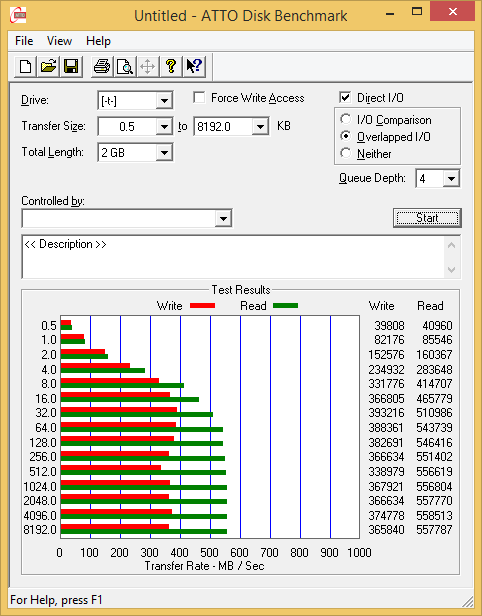 |
|||||||||
Most drives should maintain very steady performance once they hit their limit. The uneven performance on the second half of the test is a sign that the SP550 has some performance problems that deserve investigation with the rest of our benchmarks. That said, the graphs aren't as inconsistent as the Crucial BX200's, where it was obvious that it had severe issues.
AS-SSD
AS-SSD is another quick and free benchmark tool. It uses incompressible data for all of its tests, making it an easy way to keep an eye on which drives are relying on transparent data compression. The short duration of the test makes it a decent indicator of peak drive performance.
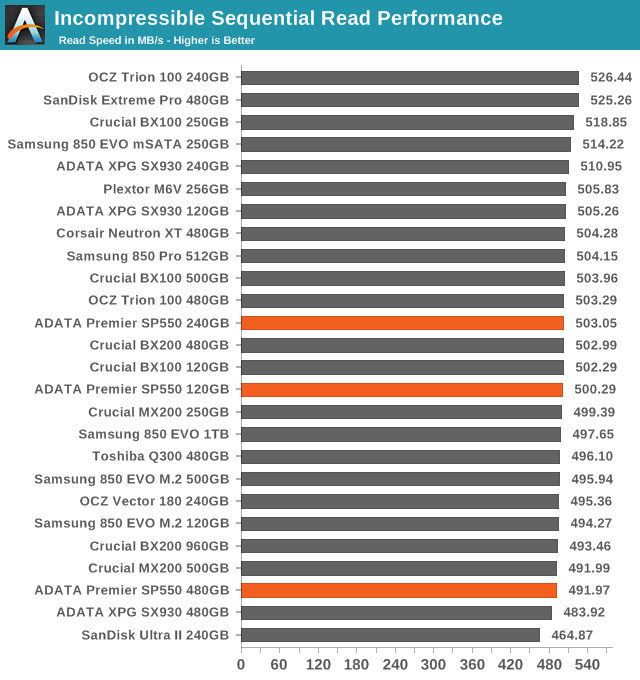
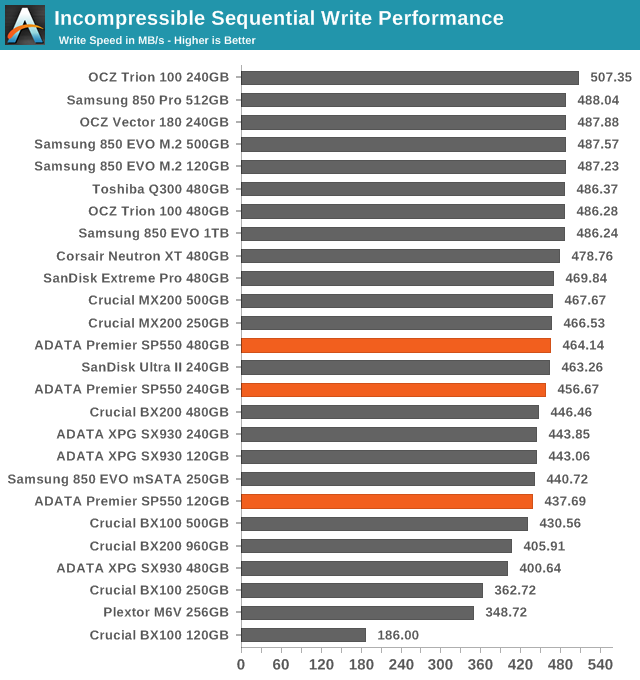
The AS-SSD test is short enough that the SP550 doesn't run out of SLC cache headroom and into trouble, and its peak performance is fine for a low-end drive.
Idle Power Consumption
Since the ATSB tests based on real-world usage cut idle times short to 25ms, their power consumption scores paint an inaccurate picture of the relative suitability of drives for mobile use. During real-world client use, a solid state drive will spend far more time idle than actively processing commands. Our testbed doesn't support the deepest DevSlp power saving mode that SATA drives can implement, but we can measure the power usage in the intermediate slumber state where both the host and device ends of the SATA link enter a low-power state and the drive is free to engage its internal power savings measures.
We also report the drive's idle power consumption while the SATA link is active and not in any power saving state. Drives are required to be able to wake from the slumber state in under 10 milliseconds, but that still leaves plenty of room for them to add latency to a burst of I/O. Because of this, many desktops default to either not using SATA Aggressive Link Power Management (ALPM) at all or to only enable it partially without making use of the device-initiated power management (DIPM) capability. Additionally, SATA Hot-Swap is incompatible with the use of DIPM, so our SSD testbed usually has DIPM turned off during performance testing.
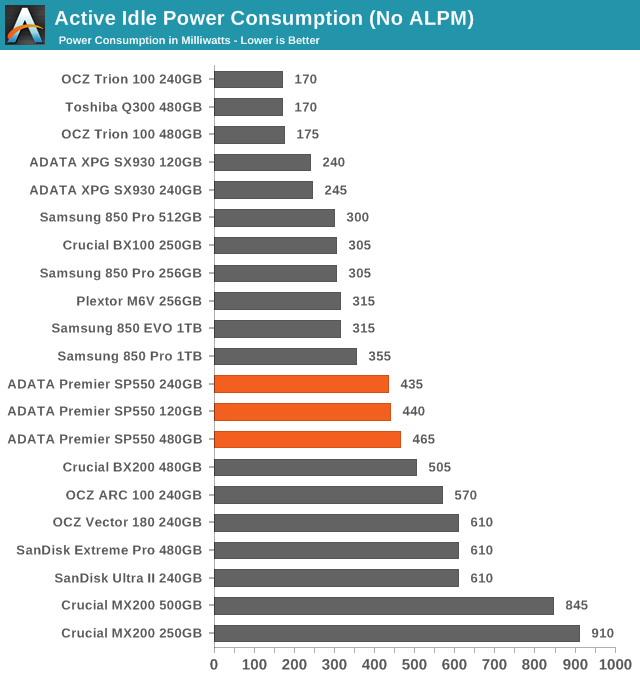
When aggressive link power measurement is disabled, the SP550 doesn't do a particularly good job of saving power, and is much worse than its Phison-based competition.
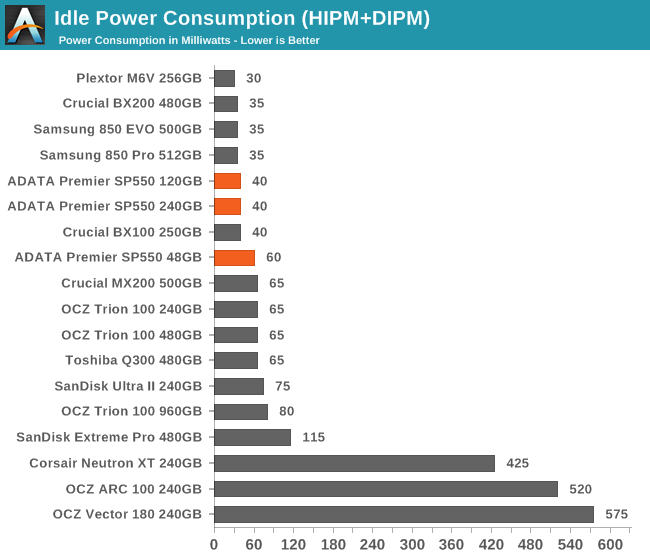
However when the SP550's power saving modes can kick in, Silicon Motion's efficiency shines and the idle power drops to near the limit of our meter's resolution. The Phison-based TLC drives fall slightly behind and the drives that don't implement device-initiated power management stand out.










25 Comments
View All Comments
zmeul - Wednesday, March 23, 2016 - link
I have the 120GB version and I'm disapointed in it - after just one month it started showing cell voltage drift and on the 2nd month it gotten worse: https://i.imgur.com/l3zonQn.pngnote: it's on a SATA2
A-Data offers no FW update for this drive
hojnikb - Wednesday, March 23, 2016 - link
Thats pretty much what you can expect with any sub 20nm TLC drive.zmeul - Wednesday, March 23, 2016 - link
well, I wish I knew that before I bought itbut neither Anand or any other site does this kind of "over time" testing
Samus - Thursday, March 24, 2016 - link
Basically you've found out first hand: AVOID any TLC drive, even TLC VNAND from Samsung isn't immune to what you are experiencing. At least you only spent $40. I still think the BX100 and OCZ ARC 100 are\were the best value, but they've spiked in price because they are no longer in production and the BX200\Trion 100/150 are a joke. My cheap go to drives now are Sandisk SSD Plus. Super cheap drive, still MLC, and suspect a reliable Marvell controller. Even the Sandisk Z400s is a reliable drive if you can get over the pretty poor performance...at least it isn't TLC performance.The laws of physics are being toyed with using NAND in TLC mode. You can't reliable store 3 values in a binary state. My childish layman's explanation goes like this: With SLC it was simple because if it was "on" it was a 1. With MLC if it was "on" it was a 1 and if it was "off" it was a 1. Using TLC, if its "on" it's a 1 if it's "off" its a 1 and if its "half" it's a 1. LOL
hojnikb - Thursday, March 24, 2016 - link
Actually, vnand tlc is just fine and possibly better than ~15nm MLC.Much larger cells offset the 3 bit per cell disadvantage.
Samus - Thursday, March 24, 2016 - link
I get that it's 40nm, so "leakage" isn't really an issue, but it still suffers from TLC's inherently poor write performance. I still prefer MLC. Especially since, as it stands right now, MLC and TLC drives are virtually the same price. I still pickup old Crucial M500's and Intel SSD320/X25-M's...and occasionally you can find new M500's in retail (Microcenter has the M550 256GB models for $60 right now)Well, they DID. I bought the last 5 at my local store I guess. http://www.microcenter.com/product/453561/256GB_SA...
They have the M500 240GB new for $67.99. Quality Marvell controller, MLC NAND, proven firmware and reliability. Until TLC drives are half that price for the same capacity I don't see what the big deal is.
KAlmquist - Thursday, March 24, 2016 - link
I'm have a hard time believing that 16nm TLC NAND is a good idea. The problems that Samsung has had with data degradation on the 840 EVO suggests that even with 19nm TLC NAND the cell size is too small. While the reviewed drive is priced attractively, I'd be more inclined to buy an MLC drive, or the Samsung EVO 850, which is TLC but with a large cell size.LarsBars - Thursday, March 24, 2016 - link
The MU02 firmware update for the Crucial BX200 resolved the strange ATTO plots that were mentioned in this review. At least for me.jabber - Friday, March 25, 2016 - link
Mmmmm the BX200. The one I got in to test finally bottomed out at a super 40MBps write speed. That was about 6 weeks ago with the latest firmware then. BX200 = Junk. The BX100, now that was and still is a quality drive.bogdan_kr - Saturday, March 26, 2016 - link
@Billy TallisI would like to ask about AnandTech Storage Bench - Light. How long (typically) does it take to finish this bench?
I mean I can see it is designed to read and write about 41GB of data. SP550 480GB finished it with 299.02 MB/s average data rate score so does that mean it took about 140 seconds?